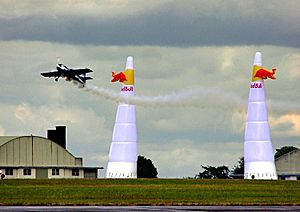G-Force facts for kids
The g-force is a way to measure how much an object's acceleration feels like the pull of gravity. Think of it as how much "heavier" or "lighter" you feel because of movement.
On Earth, when you're just standing still, you experience 1g. This is the normal pull of gravity, which is about 9.8 meters per second squared (m/s²). But when things move very fast or change direction suddenly, the g-force can become much higher or even lower.

Contents
What is G-Force?
G-force stands for "gravitational force equivalent." It tells us how strong the forces are that push or pull on your body during acceleration. When you speed up, slow down, or turn, you feel these forces.
For example, when you're in a car that suddenly speeds up, you feel pushed back into your seat. That's a g-force. When the car brakes hard, you feel thrown forward. That's also a g-force.
G-Force in Everyday Life
You experience g-forces all the time, even if you don't notice them.
- Riding a Roller Coaster: Roller coasters are great examples of g-forces in action.
* When the coaster goes down a big drop, you might feel like you're floating or lifting out of your seat. This is because you're experiencing less than 1g, sometimes even close to 0g, making you feel weightless. * When the coaster goes through a tight loop or a fast turn, you feel pushed firmly into your seat or to the side. This is because you're experiencing more than 1g.
- Driving a Car: When a car accelerates quickly, you feel pushed back. When it brakes suddenly, you feel pushed forward. These are small g-forces.
- In an Elevator: When an elevator starts moving up, you feel a bit heavier. When it starts moving down, you feel a bit lighter. These are also minor g-forces.
How Do Astronauts Experience G-Force?
astronauts experience very different g-forces than we do on Earth.
- During Launch: When a rocket launches into space, it accelerates incredibly fast. Astronauts are pushed back into their seats with several g's of force. This can make them feel very heavy, sometimes many times their normal weight. Special training helps them prepare for this intense feeling.
- In Orbit: Once in orbit, astronauts experience microgravity, which is often called "weightlessness." This isn't truly 0g, but it's very close. They float around inside the spacecraft because the g-force is extremely low.
Why is G-Force Important?
Understanding g-force is important for many things:
- Designing Vehicles: Engineers use g-force calculations to design safe cars, airplanes, and spacecraft. They need to make sure vehicles can handle the forces and that passengers are protected.
- Pilot Training: Pilots, especially those flying fighter jets or acrobatic planes, experience very high g-forces. They need special training and equipment to handle these forces without losing consciousness.
- Amusement Park Rides: Designers of roller coasters carefully calculate g-forces to make rides thrilling but also safe for everyone.
Measuring G-Force
G-force is measured in "g's." One g is the acceleration due to Earth's gravity. So, 2g means you feel twice as heavy, and 0g means you feel weightless.
For example, a top-fuel dragster can accelerate so fast that it creates a horizontal g-force of over 5g! This means the driver feels pushed back with a force more than five times their own weight.
Images for kids
-
This top-fuel dragster can accelerate from zero to 160 kilometres per hour (99 mph) in 0.86 seconds. This is a horizontal acceleration of 5.3 g. Combining this with the vertical g-force in the stationary case using the Pythagorean theorem yields a g-force of 5.4 g.
-
The Superman: Escape from Krypton roller coaster at Six Flags Magic Mountain provides 6.5 seconds of ballistic weightlessness.
See also
 In Spanish: Fuerza g para niños
In Spanish: Fuerza g para niños



